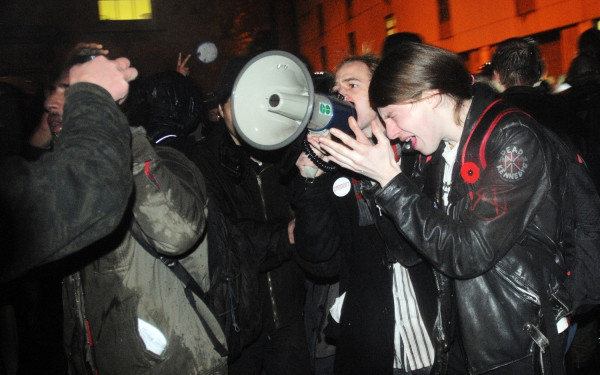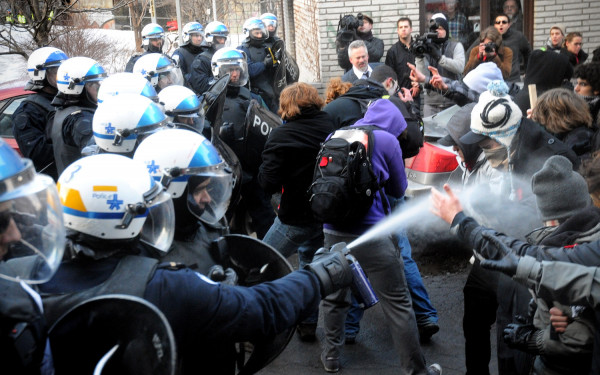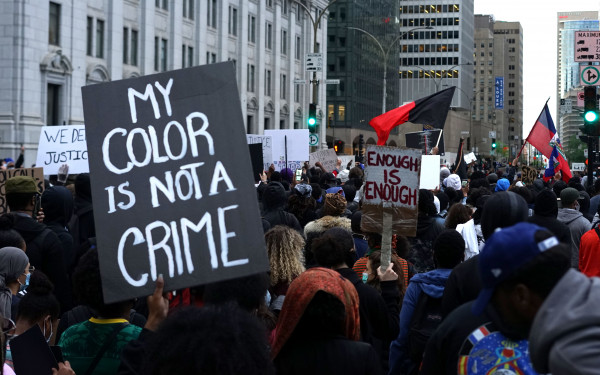ConU WTF 101
There are a lot of things about Concordia’s past you would never find in the glossy, university-issued orientation pamphlet.
This school has a long, active and damn crazy record of headline-making (for better or for worse) and inspiring mobilization and conversation from coast to coast. It’s an incredible, dynamic institution and you, dear students, are walking on historic academic ground. At Concordia, the issues are cyclical, and it’s important to know where you came from. So, here’s a quick hit of WTF has gone down at this crazy university, which might offer us a clue as to what to expect in the years to come.
1969: “Computer Centre Incident”—aka the Largest Occupation in Canadian University History
Before both campuses formally merged into Concordia, the Hall Building has long been marked by the “incident”—the first major clash over race relations, freedom of expression and, perhaps most importantly, the relationship between students and administrators.
Tensions were mounting in January of 1969 after several West Indian students accused a professor of systematic racism. Affecting more than simply their grades, black students on campus organized themselves around the official proceedings against the professor, and took their frustrations to the student newspaper The Georgian, one of two papers that later merged to form The Link.
The Georgian gave the black students total control of the issue that hit stands on Jan. 28, 1969. Now known as “The Black Georgian” the issue disseminated their concerns over the happenings on campus, as well as information suggesting that the Computer Centre in the Hall Building was a vulnerable location for security.
The administration’s response was swift and furious: the paper was culled from all the stands, the RCMP was called and the paper was locked down. The student council also fired The Georgian’s Editor-in-Chief, David Bowman.
Later, Bowman told The Link “there were people who were very upset that we gave the black students a platform. The Georgian was not the free press we thought it was. We were told the publication of the newspaper was a privilege, not a right, and for abusing that right, we were closed down.”
The next day, Jan. 29, students gathered for the hearing of Perry Anderson, the professor accused of racist conduct. Held by an all-white panel of four professors in H-110, hundreds of students walked out of the panel in protest after a few hours—and went straight for the Computer Centre.
What followed was chaos. There were 13 days of occupation, $3 million in damages and 30 years of paperwork and data destroyed. Computers were thrown from the ninth floor of the Hall Building to the streets below, and 97 students were arrested.
Though many things that came from this incident, the most concrete legacies are an Official Code of Rights and Responsibilities, as well as hermetically sealed windows in the Hall Building. What can’t be quantified when looking back on the Computer Riot, however, is how the university set a precedent in terms of dealing with dissenting students.
—With files from Justin Giovannetti.
1970: The Strike For Santhanam
Dr. S. Santhanam was a professor so admired at Loyola College in the 1960s that students and faculty mobilized, created petitions, demonstrations, sit-ins and occupations to reverse the non-renewal of his teaching contract.
Though the college’s Senate was willing to discuss the issue, the College’s Board vetoed their reconsideration of Santhanam’s contract, prompting 50 people to demonstrate in the auditorium overnight in July 1969.
Things escalated in early 1970, after a sit-in organized outside of the President’s office turned into a five day “quasi-occupation” of the Administration Building. They closed down the school for a week after calling in 150 riot squad police officers to forcefully remove over 500 people from the building.
Dr. Santhanam was eventually given a full year’s salary, had the cost of his legal fees covered, and was given a letter of recommendation in April of 1970.
1992: The Fabrikant Murders
One of the more chilling pages in the university’s history books happened on Aug. 24, 1992, when former Mechanical Engineering Professor Valery Fabrikant—believing there was an academic conspiracy against him—opened fire on the ninth floor of the Hall Building. He killed the Mechanical Engineering Department Chair and three other professors.
Choosing to defend himself after firing 10 lawyers at his trial, Fabrikant was found guilty of first-degree murder and sentenced to life imprisonment.
After the shooting, ConU enforced new codes of ethics and signed a Coalition for Gun Control petition calling the federal government to legislate tougher firearm laws.
A permanent memorial of four tables in the lobby of the Hall Building was created shortly thereafter to commemorate the four who died.
The 1987 Day Of Action
Rising tuition—and students protesting it—is hardly a new thing.
In 1987, Concordia students united for a “Day of Action” against the possibility of doubling tuition fees and chronic underfunding from the provincial government.
Besides a huge letter-writing campaign that saw over 10,000 letters sent to local MNAs and the Quebec Premier, the Day of Action sent a protest delegation to the National Assembly in Quebec City to speak with the Education Minister.
Over 1,000 students followed Concordia reps to Quebec and hundreds of students and staff held public demonstrations in Montreal. Quebec government offices were also inundated with calls from protestors against the hike.
Mass student protests continued across the province during the ‘90s, and by 1999, Concordia’s student movement took a more radical turn after students held a referendum and voted overwhelmingly in support of a strike, which lasted from November 3 to 5.
Though student representation in the Senate and increasing corporate presence on campus were cited as additional reasons for striking, the real ire of students who mobilized came after Quebec announced provincial education cuts to the tune of $1.9 billion over a six-year period.
Three thousand students took to the streets of downtown Montreal, with the Concordia Student Union leading the way. The University granted academic amnesty for students participating in the demonstrations. Concordia’s Senate also supported the students’ call for the restoration of the $1.9 billion.
From 1999 to 2001, the CSU also organized a series of mass mobilizations on campus, including a two-day student strike which succeeded in lowering student fees by $90 a year.
(All this to say: student action works, historically.)
2000: The CSU embezzlement scandal
In October of 2000, the CSU announced that $193,000 had been embezzled from its funds. After an official investigation, the Montreal Police charged former CSU VP Finance Sheryll Navidad with fraud. Concordia students learned a valuable lesson on the subject of giving a damn about what the student government is doing with their money. (Incidentally, you can find this year’s budget at csu.qc.ca.)
2002: The Netanyahu Riot
Suspiciously absent from the Concordia Archives search engine, yet one of the most famous clashes on campus, the Netanyahu Riot is the reason you may have heard this institution being referred to in passing as “Gaza U.”
When then-former Israeli Prime Minister Benjamin Netanyahu—who is currently back in power—came to speak at Concordia on Sept. 9, 2002, things got crazy.
An estimated 2,000 people came out to protest the speech—which reportedly planned no time for a question and answer period, and selectively chose audience members—and tempers flared. Windows in the Hall Building were smashed, tear gas filled the mezzanine and violence erupted as student demonstrators clashed with police. Five students were arrested and 12 were suspended.
It was the third time in a two-year period that Netanyahu had his talks cancelled at North American universities after UC Berkeley and Northwestern University had also protested his presence on campus.
After the riot, former (and now current) University President Frederick Lowy orchestrated a huge expansion of the security apparatus on campus, and expelled many student activists. A month-long moratorium was put on all Mid-East related events.
But perhaps the most controversial security post-riot move was Lowy’s creation of a Risk Assessment Committee—a highly elusive administrative body made up of an unknown number of unknown members that’s responsible for vetting all on-campus events for “security risks.” It remains active today.
Eventually, the National Film Board of Canada made Discordia, a documentary about the events on campus, which can be seen at nfb.ca/film/Discordia.
2005: The Faubourg Deal
Six years later, and we’re still dealing with this. Click here to find out more.
2009: CFS Defederation Denied
A couple years back, the Concordia Student Union became one of 13-plus schools currently attempting to leave the Canadian Federation of Students, a national student lobby group.
In September of 2009, a successful petition campaign began circulating on campus, soliciting signatures from Concordia’s undergraduate and graduate students to hold a referendum to break off from the CFS.
The relationship between both student groups had disintegrated over the years, with the CFS coming under fire for alleged misspending of fees, stagnating campaigns, failure to lobby the government for students’ rights and interference in local elections.
At the CFS Annual General Meeting in November 2009, Concordia delegates were reportedly harassed and intimidated. Concordia’s reps—along with seven other delegations from across Canada—eventually walked out during plenary.
Inciting this protest was “Motion Six,” a proposal to change the minimum percentage of student signatures required to hold a referendum to leave the CFS from 10 to 20 per cent, which was passed despite being two per cent shy of the votes required for approval.
After the AGM, the CFS retroactively applied it to Concordia’s 288-page petition, which had garnered the signatures of 16.9 per cent of Concordia students.
The CFS also claimed the union owed them $1,033,278.76 in unpaid fees, despite both the CSU and Concordia University finding no proof of outstanding dues.
In March 2010, 72 per cent of Concordians who cast their ballot voted to leave the CFS, yet the referendum has yet to be recognized by the national lobby group.
A few months later, at a May 28 general meeting in Ottawa, the CSU called for a motion from the CFS to recognize their referendum. The motion was shot down immediately and ruled as being “out of order.”
The CSU has since withheld $600,000 in unpaid fees in protest, paying their legal fees with the interest on the dues. On March 17, 2011, the CSU became the 8th student union in Canada to attempt to sue their way out of the organization. So we’re going to court. Stay tuned.
—With (many) files from Justin Giovannetti.
2000 – Present: The Governance Crisis
Since 2000, the university has reportedly given out $10 million in settlements to 45 departed administrators. Since 2005, five of the university’s VPs have resigned. Since 2007, the university has dismissed two presidents. On paper, something seems terribly amiss in the upper echelons of this administration, and the figures—both monetary and public—tell an interesting tale of tension between Concordia’s academic vision and its governing body.
Notably, in 2007 former president Claude Lajeunesse walked away with a $1.3 million severance package after a closed-door meeting with the Board of Governors. His successor, Judith Woodsworth, who came into the fray in November 2008, was let go two-and-a-half years into her mandate with $703,500.
While Woodsworth was in office, three VPs and a number of high-level administrators either stepped down or were fired with severance packages. VP Finance Larry English left in 2009. In September 2010, Concordia’s award-winning VP Alumni relations Kathy Assayag resigned her post. A few weeks later, Concordia’s longtime VP Services Michael DiGrappa left the university to pursue a job at McGill.
In the aftermath of this administrative exodus—especially after the dismissal of Woodsworth on Dec. 22—intense public scrutiny was fixed squarely on Concordia’s Board of Governors, who handpicked Interim President Frederick Lowy to serve a second term.
Since Lowy’s reinstatement, nearly every major union and association representing the university’s 41,000 students and 7,000 staff has called for a radical overhaul of the Board, demanding that Chairperson Peter Kruyt resign. Last March, he told reporters he would “not walk away” from his duties.
Since the unanimous call for their resignation, the Board of Governors approved the formation of an independent External Governance Review committee, whose report was published on June 15, 2011.
Making 38 recommendations of the roles and responsibilities of the Board of Governors, the Senate and the President, the report will go to Senate on Sept. 9 and then to the Board for approval. It is expected that phase one of the restructuring plan will begin as early as Sept. 28.
Currently, Concordia University is putting out a call for nominations of Board members and the President. And yes, the average student (that means you) can make suggestions, by going to surveymonkey.com/s/H7GZVJN. Stay tuned.
—With files from Christopher Curtis and Justin Giovannetti.
— With files from archives.conocrdia.ca (Thanks!)
This article originally appeared in Volume 32, Issue 02, published September 6, 2011.

web__900_714_90.jpg)
_600_832_s.png)




__600_375_s_c1.png)